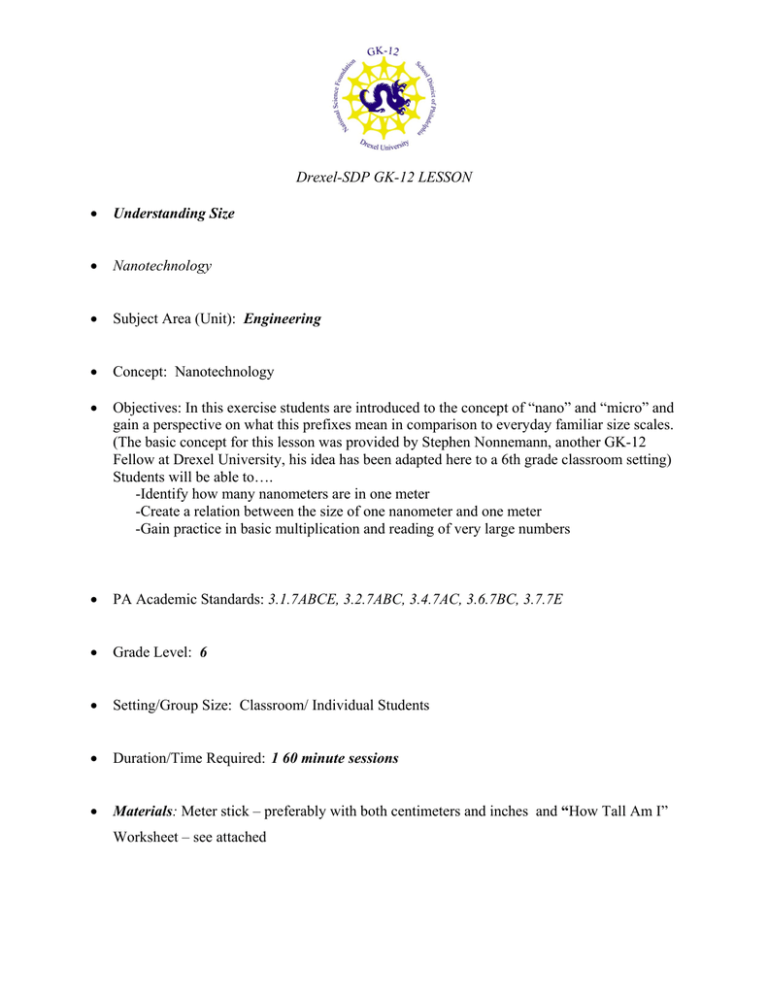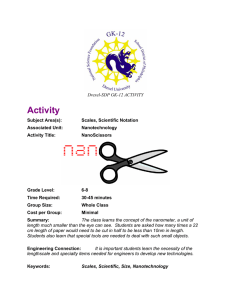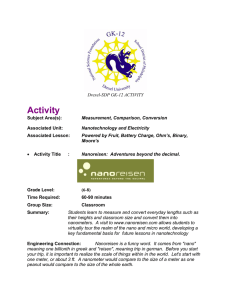Understanding Size Nanotechnology Engineering
advertisement

Drexel-SDP GK-12 LESSON • Understanding Size • Nanotechnology • Subject Area (Unit): Engineering • Concept: Nanotechnology • Objectives: In this exercise students are introduced to the concept of “nano” and “micro” and gain a perspective on what this prefixes mean in comparison to everyday familiar size scales. (The basic concept for this lesson was provided by Stephen Nonnemann, another GK-12 Fellow at Drexel University, his idea has been adapted here to a 6th grade classroom setting) Students will be able to…. -Identify how many nanometers are in one meter -Create a relation between the size of one nanometer and one meter -Gain practice in basic multiplication and reading of very large numbers • PA Academic Standards: 3.1.7ABCE, 3.2.7ABC, 3.4.7AC, 3.6.7BC, 3.7.7E • Grade Level: 6 • Setting/Group Size: Classroom/ Individual Students • Duration/Time Required: 1 60 minute sessions • Materials: Meter stick – preferably with both centimeters and inches and “How Tall Am I” Worksheet – see attached • Context: This is the introductory lesson on nanotechnology. It introduces the students to concept of a nanometer by asking them to measure themselves and calculate their own height in nanometers. It serves both as an introductory science lesson and a simple mathematical exercise. Nanotechnology has become an important field in science and engineering. The concept of nano has also become a commercial term with the introduction of the iPod Nano, as well as new products touting nanotechnology and nano-engineering in their products. The idea of what a nanometer actually is in relation to the everyday size scale we are familiar with can be somewhat difficult. By introducing the students to ideas about what is “small” and what items that they are familiar with fit into what size scale, they can gain a better perspective on what a nanometer and along with it a micrometer is. • Methods and Procedure: • Begin by asking the question “What is a nanometer?”, “Who has ever heard the term ‘nano’ before?”. What do you think of when you hear the terms nano or micro? • The students engage you in a discussion on the two terms, their ideas and knowledge about what they mean and where we might see them mentioned in everyday life. Lead the discussion to the idea of small things. After some discussion, ask the students to list as many of the tiniest things they can think of. If their suggestions are vague, help them to clarify or simplify it down to a concrete item – for instance “air” can be “a molecule of air” or even just “a molecule”. Have the students suggest a list of 10 to 15 items. • After the list is complete, have them re-order the list on a sheet of paper from largest to smallest. What is the biggest “tiny” item and what is the smallest. Order the list yourself as well and allow some discussion in small groups. Ask several students to read their list aloud and mark their results on the board. Finally, mark your own answers on the board as “hopefully” the correct listing. Point out ambiguities and take comments and questions on why your list is in the order that it is in. • “So what is a nanometer?” On the board describe the conversion from inch to meter. Then go to decimeter, centimeter, millimeter, micrometer and finally nanometer. You may even want to mention an Angstrom, pico and femto and atto. • I found that the best method for this was counting zeroes and reminding students what division by ten means in terms of real life so they can begin to imagine how small a nanometer is. Comparison to the earth work as well: Soccerballs:Earth = Nanometers:Meters. Work the ideas of rations into the lesson as well if appropriate. • Ask one student to guess how tall they are in nanometers. Then ask each student to mark down their own guess on their worksheet. After that have them begin to complete the worksheet by working together to measure each other’s height in meters and inches. They can then take these measurements and use the worksheet to convert them into micrometers and then nanometers. Assist students in completing the worksheet as necessary. At completion ask the students to read to the class their height in nanometers. Assessment: After the worksheet is complete ask some follow-up questions. You can also challenge them to take a sheet of paper and see how many times they can divide it up into ten pieces until it is too small to handle. Ask them to take a few minutes to write-up their thoughts in their science notebook. Worksheet Completion Science Journal Entry Teacher Observation Checklist • Keywords: Nanotechnology • Author: Eric Gallo Understanding Light-What Did we learn from the laser maze and our experiments with LED’s How did the laser react to different materials? Material What happened to the light? How did the shape change? Mirrors Cardboard Magnifying Glass Microscope Lens Glass Bottle Draw a diagram of the light that came out of the laser, flashlights and LEDs. How is the light different, what is different about the shape, brightness and direction? If I shine the laser at an angle to a mirror where will it hit? How do you know? Laser Mirror What different problems did you encounter when you were guiding the laser through the maze? What happened, why did it happen? What other observations did you make about light? What did you notice that you didn’t know before? What experiments could you do to learn more about the different sources of light? Why do you think understanding light might be important to an engineering designing a wireless communication system? Where do you find different sources of light in your home? Which type are they and why do you think they are used there?



